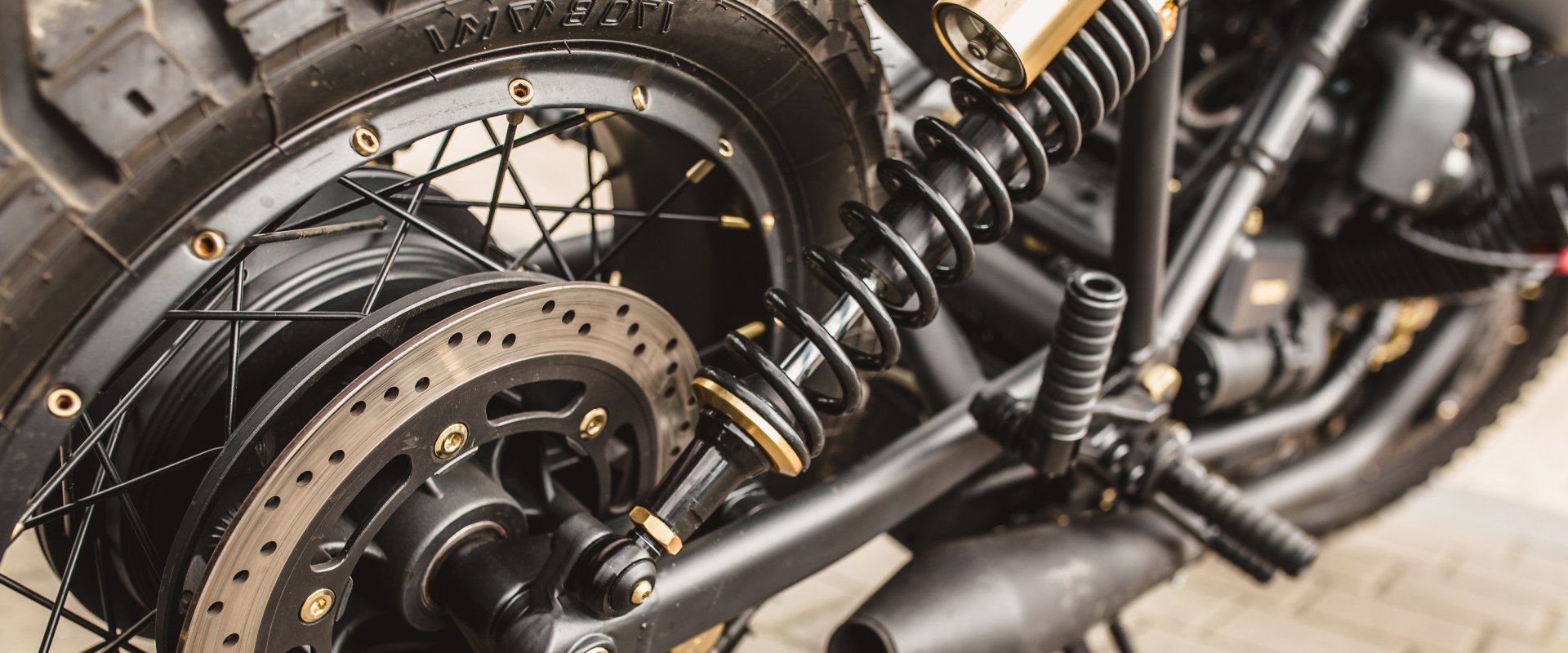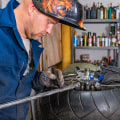When it comes to maintaining your motorcycle, brakes and suspension are two of the most important components to consider. Not only do they help keep you safe on the road, but they also affect your bike's performance and overall ride quality. If you're looking to upgrade your motorcycle's brakes and suspension, it's important to understand the different components and how they work together in order to make an informed decision. From fork springs and shock absorbers to calipers and rotors, this article will provide an in-depth look at the components of a motorcycle brakes and suspension system. We'll discuss the features of each part, the various types available, and how to select the right components for your needs.
With this information, you'll be equipped with the knowledge to make the right choice for your motorcycle's brake and suspension parts. Motorcycles are incredibly powerful machines, and one of the keys to their performance is the brakes and suspension system. There are a variety of different types of brakes and suspension systems available for motorcycles, each with their own advantages and disadvantages.
Disc brakes
are typically found on higher-end motorcycles, and are known for their strong stopping power. They offer a greater degree of control over the motorcycle's speed, and are generally more reliable than drum brakes.Drum brakes are more common on lower-end models, and while they don't offer as much stopping power as disc brakes, they are still reliable and can provide adequate braking power.
Hydraulic brakes
are found on both mid-range and high-end motorcycles, and provide excellent braking power while being relatively easy to maintain.Pneumatic brakes
are typically found on high-end models, and offer superior stopping power but require more maintenance than other types of brakes. Other forms of braking systems include electric brakes, air brakes, and mechanical brakes. When it comes to suspension systems, there are several different types available.Coil-over shocks provide a softer ride but require more maintenance than other types of suspension systems.
Air shocks
provide a firmer ride but require less maintenance than coil-over shocks.Progressive suspension
is another type of suspension system that provides a smoother ride but also requires more maintenance than other types of suspension systems. In order to keep your motorcycle's brakes and suspension system in top condition, it's important to perform regular maintenance checks. When checking for signs of wear and tear, look for any signs of cracking or corrosion on the brake pads or discs, as well as any leaks from the hydraulic lines or air hoses.It's also important to make sure that all of the bolts and screws are properly tightened and that the brake pads are correctly aligned with the discs. Properly adjusting the brake and suspension settings can help ensure that your motorcycle is performing at its best. When it comes to lubrication, it's important to use the correct type of lubricant for your motorcycle's brakes and suspension system. Different types of brakes require different types of lubricants in order to remain in optimal condition. Make sure you consult your motorcycle's owner's manual to determine what type of lubricant is best for your particular model. In addition to regular maintenance checks, it's also important to properly clean your motorcycle's brakes and suspension system.
This will help ensure that it is free from dirt and debris which can cause premature wear and tear. Make sure you use a soft brush and mild detergent when cleaning your motorcycle, as harsh chemicals can damage the delicate components. Finally, when it comes to safety, it's important to always check your brakes and suspension before taking off on a ride. Make sure you check for any signs of wear or damage before riding, adjust the settings according to your weight, and be aware of the road conditions before taking off. If you notice any signs of wear or damage, it may be time to replace your brakes or suspension system.
When choosing a new system, make sure you select one that is appropriate for your type of motorcycle.
Suspension Systems
Suspension systems are used to absorb the shock from bumps in the road, providing a smoother ride and improved handling for riders. There are several types of suspension systems used on motorcycles, each with their own benefits and drawbacks.Coil-over shocks
are typically used on off-road motorcycles. These shocks are adjustable, allowing riders to fine-tune the suspension for different terrain and riding styles.Air shocks are more common on sport bikes, as they provide a softer, more comfortable ride. They are also adjustable, allowing riders to adjust the suspension to their preferences.
Progressive suspension
is used on many touring motorcycles, providing a more comfortable ride over long distances. This type of suspension is less adjustable than other types, but is still effective in providing a smooth ride.Hydraulic Brakes
Hydraulic brakes are becoming increasingly popular on motorcycles. They use a hydraulic fluid system to generate pressure on the brake pads, which then presses against the metal disc or drum to stop the wheel. This system is more powerful and efficient than other types of brakes, such as cable-actuated brakes, and provides better braking performance and control. The hydraulic system also helps to reduce wear and tear on the brake pads, allowing for a longer life span.When maintained properly, hydraulic brakes can provide reliable stopping power for many years. The main components of a hydraulic brake system are the master cylinder, the caliper, and the brake pads. The master cylinder is responsible for supplying the pressurized hydraulic fluid to the caliper, which is then used to move the brake pads against the rotating disc or drum. The caliper holds the brake pads in place and ensures that they make contact with the disc or drum when pressure is applied.
Additionally, the caliper also houses a set of pistons which apply pressure on the brake pads when the master cylinder is activated. In order to keep your hydraulic brakes in top condition, it is important to regularly check the fluid levels and clean any dirt or debris from the caliper and master cylinder. Additionally, it is important to ensure that all components are properly lubricated in order to reduce wear and tear on the parts. If any problems are discovered, it is important to have them addressed as soon as possible in order to avoid damage or further deterioration of the braking system.
Drum Brakes
Drum brakes are another type of brake used on motorcycles.They work by pressing two shoes against the inside of a metal drum. This type of brake is usually found on older, classic-style motorcycles, but is becoming increasingly rare on newer bikes due to their lower performance compared to disc brakes. Drum brakes require more frequent maintenance than disc brakes, as they tend to wear down more quickly. The shoes must be replaced regularly, and the inside of the drum must also be checked for signs of wear or damage.
It is also important to check the brake fluid regularly and top it up as necessary. In addition, the drum itself must be inspected for any signs of rust or corrosion, as this can cause the brakes to fail. If any rust or corrosion is detected, the drum should be replaced immediately. Finally, it is important to make sure that the brake shoes are in good condition.
If they are worn or damaged, they should be replaced as soon as possible.
Disc Brakes
Disc brakes are one of the most popular types of motorcycle brakes. They use a metal disc that rotates with the wheel to create friction and stop the wheel from spinning. Disc brakes are typically very reliable and require minimal maintenance. When properly maintained, disc brakes can provide years of reliable service.The main components of a disc brake system are the rotor, caliper, pads, and pistons. The rotor is a metal disc that is attached to the wheel. When the brake pedal is pressed, the caliper squeezes the brake pads against the rotor, creating friction which slows down the wheel. Disc brakes are generally more powerful than drum brakes and provide better stopping power.
They are also less prone to fading due to heat buildup, making them ideal for high-performance applications. Disc brakes require less maintenance than drum brakes and can last for many miles without needing to be replaced. When it comes to maintaining your disc brakes, it's important to check them periodically to make sure they are in good working order. You should inspect your brakes for signs of wear or damage, and replace any worn or damaged parts as necessary.
Additionally, you should regularly check your brake fluid level and top it off if necessary. Overall, disc brakes offer superior performance and reliability compared to other types of brakes. They require less maintenance and provide excellent stopping power. If you're looking for an efficient and reliable braking system for your motorcycle, then disc brakes are an excellent option.
Pneumatic Brakes
Pneumatic brakes are a type of brake system that uses compressed air instead of hydraulic fluid to generate pressure on the brake pads.This type of brake is often used in high-performance applications where weight is a major factor. Pneumatic brakes are lighter than hydraulic brakes, as they don't require as many components, and they can provide more consistent braking performance over time. Additionally, pneumatic brakes are more reliable than hydraulic brakes, as they don't suffer from leakage or air loss. The main advantage of pneumatic brakes is that they can generate more power than hydraulic brakes, as the pressure generated by the compressed air is greater than the pressure generated by the hydraulic fluid. This makes them ideal for use in high-performance applications where stopping power is critical.
Additionally, because the components are lighter, they can be more easily installed and maintained, making them a popular choice for motorcycle riders. When using pneumatic brakes, it is important to ensure that the system is regularly inspected and maintained. This will help to ensure that the brakes are functioning properly and that there are no leaks or other issues that could lead to an accident. Additionally, regular maintenance will ensure that the system is operating efficiently and safely. If there are any problems with the system, it is important to address them quickly in order to prevent any dangerous situations. Having a good understanding of motorcycle brakes and suspension is essential for any rider looking to get the most out of their ride.
Disc brakes, drum brakes, hydraulic brakes, and pneumatic brakes are all types of brakes that can be found on a motorcycle, while suspension systems are important for providing a smoother ride. It is important to maintain your brakes and suspension system properly in order to ensure safety and performance. Regularly checking for signs of wear and tear can help you get the most out of your ride. Remember, proper maintenance of your motorcycle's brakes and suspension system is key to a safe and enjoyable ride!.



